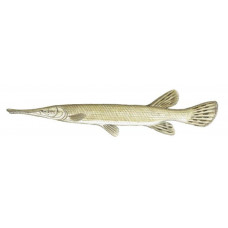Latin name
Lepisosteus platostomus
Other names
No information
Identification
The body is long and cylindrical, covered with ganoid (rhomboid) scales. The upper jaw has one row of teeth, while the alligator gar has two rows. It has a short, broad snout. Unlike its relatives, the Florida gar and the spotted gar, it does not have spots on its head, but it does have spots on its dorsal, anal, and caudal fins.
Distribution
Shortnose gar occur from the Great Lakes south to the Gulf of Mexico, but are mostly restricted to low-water portions of the Mississippi River basin. In the United States, it occurs from northern Alabama to Oklahoma and down Louisiana to the Gulf of Mexico. In the north, it has a wide range in the river systems that feed the Mississippi River from southern Ohio to Montana.
Habitat
This species is found in still water, including pools and backwaters of streams and small and large rivers, as well as in swamps, lakes, and ponds, often near vegetation. Shortnose gar are more tolerant of turbid water than other carps and prefer warm water.
Size
Shortnose gar rarely exceed 21⁄2 feet in length. The world record for any tackle is believed to be a 5-pound, 12-ounce fish caught in Illinois in 1995.
Life history and Behavior
Spawning occurs in spring in shallow bays and locks. Eggs are attached to weeds or other objects.
Food and feeding habits
The diet of the shortnose gar is similar to that of other gar. The main part of its food is forage and coarse fish.
Reproduction
No information
| Classification | |
| Phylum | Chordata |
| Class | Actinopterygii |
| Squad | Lepisosteiformes |
| Family | Lepisosteidae |
| Genus | Lepisosteus |
| Species | L. platostomus |
| Features | |
| Conservation status | Least Concern |
| Habitat | Pelagic |
| Life span, years | No information |
| Maximum body weight, kg | 2.6 |
| Maximum length, cm | 88 |
| Sailing speed, m/s | No information |
| Threat to people | Poisonous |
| Way of eating | Predator |



